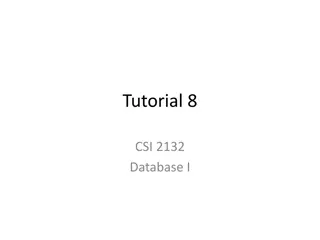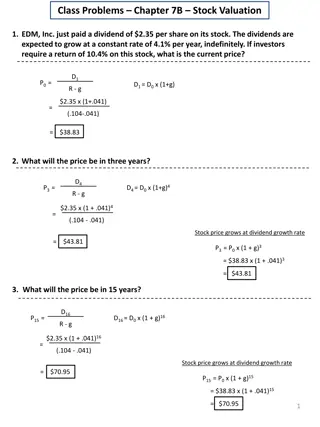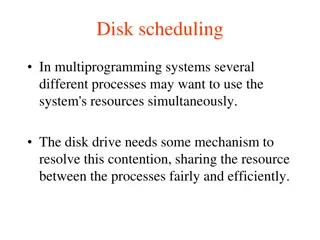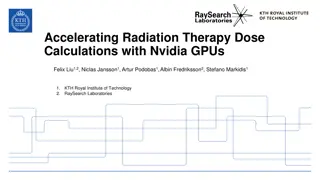Disk Performance Considerations and Calculations
Explore examples of disk performance calculations, including seek time, transfer rate, rotational speed, controller overhead, capacity calculations for platters and cylinders, and total disk capacity. Understand how to calculate average time for reading or writing data, number of platters required for a specific disk size, and time taken for data transfer between tracks on a disk. Dive into the details of disk parameters such as latency, seek time, rotational delay, and transfer speed to enhance your understanding of storage devices.
Download Presentation

Please find below an Image/Link to download the presentation.
The content on the website is provided AS IS for your information and personal use only. It may not be sold, licensed, or shared on other websites without obtaining consent from the author.If you encounter any issues during the download, it is possible that the publisher has removed the file from their server.
You are allowed to download the files provided on this website for personal or commercial use, subject to the condition that they are used lawfully. All files are the property of their respective owners.
The content on the website is provided AS IS for your information and personal use only. It may not be sold, licensed, or shared on other websites without obtaining consent from the author.
E N D
Presentation Transcript
Review / Examples Example 1: A magnetic disk has an average seek time of 5 msec. The transfer rate is 50 MB/sec. The disk rotates at 10,000 rpm and the controller overhead is 0.2 msec. Find the average time to read or write 1024 bytes. Solution: Average Tseek = 5 msec. Average Trot = 0.5*60 /10,000 = 3 msec. Ttransfer =1KB / 50MB = 0.02 msec. Tcontroller = 0.2 msec. The total time taken = Tseek + Trot + Ttsfr + Tctr = 5 msec + 3 msec + 0.02 msec + 0.2 msec = 8.22 msec.
Example 2: How many platters are required for a 40GB disk if there are 1024 bytes/sector, 2048 sectors per track and 4096 tracks per platter? Solution The capacity of one platter = 1024 * 2048 * 4096 = 8GB For a 40GB hard disk, we need 40 / 8 = 5 such platters. Example 3: Calculate time to read 64 KB (128 sectors) for the following disk parameters. 180 GB, 3.5 inch disk 12 platters, 24 surfaces 7,200 rpm; (4 msec avg. latency) 6 msec avg. seek (r/w) 64 to 35 MB/sec (internal) 0.1 msec controller time Solution Disk latency = average seek time + average rotational delay + transfer time + controller overhead = 6 msec + 0.5 * ((60000 msec) / (7200 rpm)) + 64 KB / (64 MB/sec) + 0.1 msec = 6 msec + 4.16667 msec + 1.0 msec + 0.1 msec = 11.26667 msec.
Example 4: Consider a hard disk that rotates at 3000 rpm. The seek time to move the head between adjacent tracks is 1 msec. There are 64 sectors per track stored in linear order. Assume that the read/write head is initially at the start of sector 1 on track 7. How long will it take to transfer sector 1 on track 7 to sector 1 on track 9? Solution Time for one revolution = 60 / 3000 = 20 msec. Total transfer time = sector read time + head movement time + rotational delay + sector write time. Time to read or write on sector = 20 / 64 = 0.3125 msec /sector. Head movement time from track 7 to track 9 = 1msec * 2 = 2 msec. After reading sector 1 on track 7, which takes 0.3125 msec, an additional (20 0.3125 = 19.6875 msec of rotational delay is needed for the head to line up with sector 1 again but on track 9. (The head movement time of 2 msec gets included in the 19.6875 msec). Total transfer time = 0.3125 msec + 19.6875 msec + 0.3125 msec = 20.3125 msec.
Example 5: Consider a (very old) disk with the following characteristics: - block size B = 512 bytes. - gap size G = 128 bytes. - 20 sectors per track. - 400 tracks per surface. - 15 double-sided platters. disk platters rotates at a speed of 2400 rpm, average seek time 30 msec, (all numbers are given as a factor of 2, i.e., KB = 2^10, MB = 2^20) What is the total capacity of a track? Total = 20 * (512+128) = 12800 bytes = 12.5 KB What is its useful capacity of a track (excluding interblock gaps) Useful = 20 * 512 = 10240 bytes = 10 KB How many cylinders are there? Number of cylinders = number of tracks = 400 What is the total capacity of a cylinder? Total = 15 * 2 * 20 * (512+128) = 384000 B = 375 KB What is the useful capacity of a cylinder? Useful = 15 * 2 * 20 * 512 = 307200 B = 300 KB
What is the total capacity of the disk? Total = 15 * 2 * 400 * 20 * (512+128) = 153600000 Bytes = 146.48438 MB What is the useful capacity of a disk? Useful = 15 * 2 * 400 * 20 * 512 = 117.1875 MB What is the average rotational delay rd? rd = (time for one disk revolution) / 2 = ((60 * 1000) / 2400) / 2 = 25 / 2 = 12.5 msec. What is the total transfer rate (ttr)? ttr = (total track size in bytes) / (time for one disk revolution) = (12800 bytes) / (60 / 2400) s = 12800 B / 25 msec = 500 KB/s. What is the efficient (formatted) transfer rate (etr)? etr = (useful capacity of a track) / (time for one disk revolution) = (10240 bytes) / (60 / 2400) s = 10240 B / 25 msec = 400 KB/s. What is the sector transfer time (stt)? 512 / (512 + 128) * 360 / 20 = 14.4 degrees per sector. stt = 14.4 / 360 * 25 msec = 1 msec.

























